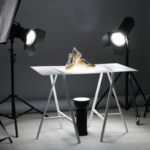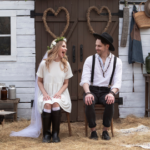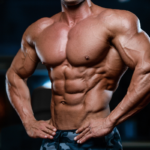A growing photography niche, fitness photoshoots have become more and more popular as social media has developed and become such a large part of the photography business. With countless fitness models hoping to make the transition into fitness influencing, there has never been a higher demand for fitness pictures and fitness content.
With such impressive growth, there’s no better time than the present to learn the tricks of the trade, seek out professional athletes or professional fitness models, and start to establish yourself as a professional fitness photographer.
The Best Tips For Starting Fitness Photography Before The Shoot
Decide On A Location
The majority of the time you spend shooting fitness photography, you will need to organise a location for the shoot to take place.
 Unless you’re lucky enough to be shooting a fitness photoshoot for a gym or a promo for a piece of specific equipment, you’ll need to organise a location to take your photos. While this offers you the freedom to take photos wherever you want, you will need to be proactive in finding and securing a location ahead of time that works for you and your client.
Unless you’re lucky enough to be shooting a fitness photoshoot for a gym or a promo for a piece of specific equipment, you’ll need to organise a location to take your photos. While this offers you the freedom to take photos wherever you want, you will need to be proactive in finding and securing a location ahead of time that works for you and your client.
When choosing a location you should ensure that you consider the atmosphere you want to create and the message that you want to communicate through your photography. For example, if the fitness photo sessions are for fitness magazines that revolve around healthy living, you might consider doing them outdoors. On the other hand, a professional bodybuilder may benefit from a session in the studio since you want to highlight their body while they perform specific poses and routines that make sense in the context of the studio.
Experiment With Shots
As with learning any photography style, practicing your shots will always be beneficial experience. So before your shoot, you should try to see if there is any opportunity to practice the type of shots you’re planning on taking on the day, testing out the lighting of the photoshoot location and different model poses. This is especially important with fitness photoshoots as gyms rarely the best lighting for photos.
So, if you get the chance to enter your location early, make sure to take a few test shots in different locations around the gym to find which spot is best for the photoshoot. This also allows you to select the right tools for the job, as if you discover in your test shoots that your lens in simply too long for an intimate gym shoot, then you’ll have a better chance to swap it out before the actual shoot, making your final product that much better.
Prepare A Shot List
A key part of fitness photoshoot preparation is planning out what you want, ahead of time.
 Photographers need to think ahead to avoid wasting time while getting the best fitness photos, as you cant just enter a shoot with only a few ideas about what you want. As such, the best thing fitness photographers can do to prepare is write down the shots they need. This shot list should describe in detail, the angle, focus and style of shot required, as well as how to obtain them.
Photographers need to think ahead to avoid wasting time while getting the best fitness photos, as you cant just enter a shoot with only a few ideas about what you want. As such, the best thing fitness photographers can do to prepare is write down the shots they need. This shot list should describe in detail, the angle, focus and style of shot required, as well as how to obtain them.
During a photoshoot, it is easy to get overwhelmed with all the activities, but luckily writing down the shots needed in a shot list ensures that nothing is forgotten. So, whether you’re shooting for a fitness coach or an amateur bodybuilder, thinking about how to approach shots ahead of time will always be the right choice, and will ensure that as soon as you step foot onto a fitness photoshoot, you will know exactly what to do and not waste time thinking about how to approach it.
“Thinking ahead about how to approach shots ahead of time will always be the right choice”
What To Do On The Day Of The Shoot
Communicate with the Model
Even with the best camera and lighting, a good photoshoot depends on the collaboration of the model and photographer. As such, communication between the photographer and the model is one of the key elements that will guarantee the best results.
 Tell the model what style you want in the photos, bring some sample photos of good fitness poses, do whatever you need to incorporate your model into the creative decision making. This is very important as it will help the model feel more confident and allow the photographer to capture the desired photos in less time.
Tell the model what style you want in the photos, bring some sample photos of good fitness poses, do whatever you need to incorporate your model into the creative decision making. This is very important as it will help the model feel more confident and allow the photographer to capture the desired photos in less time.
If the model is an athlete or a fitness expert, or even if they’re just starting out, make sure to listen to their advice. Photographers know how to take a good photo, but the models knows what appeals to their target audience, so make sure to ask them for feedback on ways to improve your fitness photos.
Don’t Be Afraid To Ask For What You Want
In order to have a successful fitness photoshoot, be aware that your main role is to capture an aesthetically appealing snapshot of a certain activity or pose, even when that activity or pose isn’t as photogenic as it could be. To put it simply, sometimes athletes perform tasks in ways that are not very appealing to the camera. For example, a marathon runner may run in a way that saves energy but does not look good on camera. In cases like this, its important to remember that as a photographer, you can control every aspect of your frame, and if you need a shot that is a little outside the reality of the activity, you’re well within your rights to ask for it.
This means a fitness photographer can have their model athlete do the basic activity, but they can also request some tweaks to create a better frame, angle, or overall shot. of course, these tweaks should maintain authenticity but will definitely result in a more powerful image.
“As a photographer, you can control every aspect of your frame”
Experiment With Natural Light
 The natural light from a window is well known to be some of the best sources of light, loved by all photographers. A large window provides an opportunity to create direct light, side light, or backlight, allowing for a large variety in pictures. What’s even better is that this light can be controlled through the use of netting or reflectors to diffuse light and create gentle and soft tones.
The natural light from a window is well known to be some of the best sources of light, loved by all photographers. A large window provides an opportunity to create direct light, side light, or backlight, allowing for a large variety in pictures. What’s even better is that this light can be controlled through the use of netting or reflectors to diffuse light and create gentle and soft tones.
As such, if you’re shooting inside, try and utilise as much natural light as possible to ensure your photos really pop.
However, if a photoshoot is outside, the photographer will need to play with the natural light to get the right look, but be more aware of the harshness of this unadulterated light source. During the middle of the day, the sun can be too harsh to for many cameras without the use of some sort of diffusion, which involves a complicated set up that may be beyond an amateur photographer’s skills.
As such, the best time for an outdoor photoshoot is about an hour before the sun goes down, known as golden hour. The light during this golden hour is softer and well loved by photographers as it does not create sharp shadows, and looks extremely aesthetically pleasing when shot.
Get Every Angle
 One of the best things about photography is the chance to shoot any angle you feel like, with a the ability to sort through your images after the shoot and decide which ones are the best. This is especially useful in fitness photography as the the angle of the light hitting the subject and the pose angle determines what is emphasized in the photo, with straight-on light flattening out muscles.
One of the best things about photography is the chance to shoot any angle you feel like, with a the ability to sort through your images after the shoot and decide which ones are the best. This is especially useful in fitness photography as the the angle of the light hitting the subject and the pose angle determines what is emphasized in the photo, with straight-on light flattening out muscles.
To highlight muscles, angle the light so that shadows cross over the muscle and give it dimension. To create this effect, turn the model away from the light source, whether the sun, a window, or a light fixture. This is simple experimentation, but it works wonders at really fine tuning the photography you can put out, so make sure that on your shoot day you never stop clicking away, trying out every angle and pose that comes to your mind.
“Place models so that the curves of their muscles are prominent”
What Camera Is Best For A Fitness Photoshoot
Image quality is probably the first and foremost thing to consider when looking for a camera that can handle fitness photography. As fitness photos are often taken in low light, and action photography requires a fast shutter speed, a large sensor size with a high megapixel count will ensure that your photos are clear and sharp.
The next factor to consider is the lenses that are available for the camera. A wide-angle lens is important for capturing group shots or landscape photographs while a telephoto lens could come in handy for focusing on specific details or individuals within a large crowd. Once you decide on a lens type, also consider its waterproofing and durability standard as fitness cameras as will often have to be used in harsh conditions.
Watermark Your Images
Once you’ve selected your camera, lens, location and completed your shoot, you job still isnt done. The final step for any good photographer is watermarking their work.
 Watermarking is an important part of the process as it protects the copyright of your work and ensures that it cannot be reused or altered without your permission. This is perfect in the online photography world as it allowed you to publish your work without the threat of theft, letting people still preview your portfolio of work without the risk of thieves coming along and misappropriating your images.
Watermarking is an important part of the process as it protects the copyright of your work and ensures that it cannot be reused or altered without your permission. This is perfect in the online photography world as it allowed you to publish your work without the threat of theft, letting people still preview your portfolio of work without the risk of thieves coming along and misappropriating your images.
The best thing about watermarking however, is that it is simple and free when using WaterMarquee! WaterMarquee offers free online watermarking where you simply upload your photos and get them back with a custom watermark in no time at all. WaterMarquee also offers premium services that will really help elevate any work you produce and mark you as a true photography professional.
So what’re you waiting for, elevate your game as a fitness photographer and start watermarking your work today with Watermarquee.































